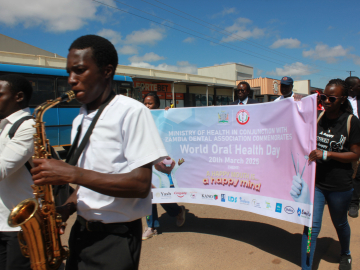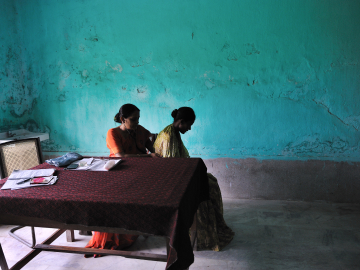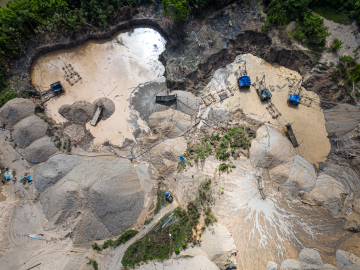Inspiration From the Ashes: A Q&A with the Filmmakers
If you don’t live in coal country, you might think of coal as someone else’s problem. If so, From the Ashes, a new documentary produced by Bloomberg Philanthropies, might change your mind. The film, which premiers globally this Sunday, June 25, on National Geographic, lays bare the public health effects of coal. The effects are real, not just for miners, but for people who live near refineries or railroad tracks with speeding trains that spew coal dust. But it isn’t just the public health issues. The film advances the argument that coal no longer makes economic sense, either. The film reveals why this “19th century innovation is not working in a 21st century world,” according to Katherine Oliver, one of the film’s executive producers.
In an exclusive Q&A, Oliver and Michael Bonfiglio, the film’s director, shared with GHN’s Dayna Kerecman Myers why they embarked on this film a couple years ago and their surprise at how coal came to dominate the headlines by the time it aired.
When you started this project, did you have any idea how much coal would emerge as a divisive issue?
KO: We had no idea. It was pure serendipity that we started working on this film and then 2 years later, as we’re releasing it, coal is being talked about daily, and the president has started initiatives that are compromising and changing the policies that had been addressing climate change and the environment for so long. We think this is the right film at the right time.
What inspired you to take on this documentary?
KO: The realization that coal refineries were directly linked to public health concerns inspired Michael Bloomberg to start working with the Sierra Club and supporting their efforts. About 2 and a half years ago, we decided to produce our first documentary, to use filmmaking as a mechanism to help educate and inform the public about the issues that we’re embracing and tackling, and decided to tell this story about the Beyond Coal campaign. And so that was the genesis of it. Our goal was to create a film very rich in data; we wanted to look at this issue and not focus on the climate conversation so much, but really look at why coal is bad for the environment—because it poses a public health threat and it no longer makes economic sense.
MB: Coal touches many different facets of life; it touches various realms of public health as well as climate. It would be relatively easy to eliminate coal from our energy sector and replace it with clean energy, and replace the lost jobs with clean energy jobs if we just had the political will to do so.
What were the sources for facts, such as 20 Americans die every day—how was that estimated, when it can be hard to pinpoint cause of death related to lung disease for example?
KO: The producers worked very closely with the Sierra Club and the Bloomberg Philanthropies environmental team to source those data points and create the infographics that really illustrate the impact that coal is having on the US.
For example, the Sierra Club’s research also reveals that for every 50 gigawatts of coal taken offline, more than 3,600 deaths and 60,000 asthma attacks are prevented and $2.3 billion in health care costs are saved each year. Closing even one coal plant can prevent 29 premature deaths, 47 heart attacks and 146 asthma attacks. Facts were also sourced from reputable sources like the Clean Air Task Force health study and the Institute for Health Metrics and Evaluation.
What do you hope the film achieves?
MB: My main goal was to make something that people would be entertained by, with human stories people can connect to. We also thought that it was very important to try to make something that wasn’t preaching to the choir, but that was inclusive regardless of people’s views on coal going into the film. We aimed to present stories that people could relate to and understand and maybe rethink their opinions as a result. We’re in a time of incredibly partisan rhetoric; these issues have become incredibly politicized. Public health and climate change are not political issues, or at least they shouldn’t be.
Was it difficult to find people to interview who were not strongly pro- or anti-coal; were most of the people you encountered heavily polarized on one side or another?
KO: The credit there goes to the producers, who did a lot of research. They worked very closely with Bloomberg Philanthropies and its environmental team as well as the Sierra Club to identify great story tellers. Whether they were directly linked, working in the coal mines, or the wives of husbands who lost their jobs, or scientists, or politicians, we found a range of people who could contribute to the conversation and share their point of view. We sought out people who were not only in coal country, but like the African-American mother in Dallas, Misti O'Quinn, coping with children who have asthma in a big city that is compromised by a coal plant. Who would have thought that a coal mine would impact her life? But Dallas has severe air pollution and very poor air quality, and that is contributing to asthma for a lot of young people.
MB: One of the people most compelling to me was Regina Lily in West Virginia. She’s from a coal-mining family, she used to work for a coal company, and her husband had been laid off from a coal mine when we talked with her and her family. She is very much caught in the middle of this. She has seen, for generations, the negative effects of coal. But it’s also in her own personal interest for the coal industry to survive in her town. It’s the only game in town for a lot of people in coal country; the only job opportunities are in the coal industry. That is problem with this whole issue; there is no economic diversification in some of these regions, and there is no choice: you either work in the coal mines or you don’t work at all. Her views on the issues were complex and nuanced and I found her fascinating; she is very passionate about these issues, but is also torn about what to do—as are a lot of people in coal country.
The mayor of Georgetown, Texas, Dale Ross, was another interesting character in the film. Are there indications other cities in “red” states might follow Georgetown’s footsteps in moving away from coal?
KO: He’s an amazing character highlighted in the film—a Republican from the reddest town in the reddest state. He’s also a CPA, and he said look, I’m not focusing on the climate conversation, I’m making a promise that my town is going to be 100% renewable because it makes economic sense. He is a voice of reason, and I think hopefully an inspiration, to others. He’s also appearing in some other films, including the Inconvenient Truth sequel, so he’s somebody who is emerging from the Republican party who is very vocal on this issue.
How did you find people from so many different walks of life and perspectives, and persuade them to open up—and would it have been harder if you had started the project this year, amid such political intensity?
MB: I don’t know if it would have been harder, but it was definitely hard. A lot of people said no, they didn’t want to talk to us. But we just tried to be incredibly honest with everybody. We wanted to explore all sides of these issues. We were looking for a diverse range of voices. We’re giving everybody their say, and treating everyone respectfully. People who did choose to participate in our film took us at our word on that, and I hope we lived up to that. Unquestionably, though, a lot of people said no. They saw the Bloomberg name and saw filmmakers from New York. But our approach was completely honest, and to not pretend that we’re anything other than what we are: genuinely curious about people’s positions on these issues. By presenting a multiplicity of voices, we hope viewers can make up their own minds and come to their own conclusions.
Who are you hoping to reach, and what are your hopes for the audience that National Geographic will bring?
KO: Once we finished the film, we started talking to prospective distributors—and we felt that National Geographic would be a great partner. They’re in 440 million homes globally. They’re going to distribute the film in different languages. And so, while we wanted to get traditional distribution by aligning ourselves with a very credible brand in National Geographic, we also are taking the film to different communities through our screening series with mayors and through over 200 grassroots screenings at community groups and universities and different organizations that are focusing on environmental issues.
We’re putting together screening guides for the people hosting these grassroots screenings, so they can lead a discussion and not only consume the film, but have thoughtful conversations about what can be done—and we hope people will be inspired to share what they’ve learned through their own social media channels.
Do you have plans for a follow-up documentary?
KO: It would be interesting to track some of those folks from the section on coalfield development, focused on the effort led by Brandon Dennison (director of the Sierra Club’s Beyond Coal Campaign) to train coal miners and help place them in new jobs, and see where life takes them. Bloomberg Philanthropies has announced a fundraising initiative through the CrowdWise platform that will match funds up to $3 million toward coalfield development to help retrain coal miners and place them in new positions. They lost a lot of their federal funding, so Bloomberg stepped in to help them out, and that is one of the calls to action mentioned in the film. We think that’s what’s uplifting about the film. Yes, we’re grappling with some challenges with the environment right now, but there are things that the average citizen can do. And by supporting this initiative, that’s one way to really make a difference.
We will also keep telling the story through social media, and our website, which we invite all to explore.
What do you hope people will take away from the film?
KO: I encourage people to watch the film on June 25, to visit the website, and to join our community by following us on Twitter and social platforms. People can also look at the CrowdRise campaign support coalfield development. People should be hopeful that there are opportunities, and we will turn this around.
MB: One of the most important things to remember is that the coal industry, despite all the talk, is not a very large industry—there are about 51,000 coal miners in America. Whole Foods has more employees. By highlighting that relatively small amount of people who work in the industry, it doesn’t mean that those people don’t matter—it means that we should be able, through innovation and creativity, to provide employment in other sectors for that relatively small number of people. Economic diversification in these regions is critical for moving past coal and to a cleaner, healthier, safer future.
This interview has been edited for clarity and length.
Join the thousands of subscribers who rely on Global Health NOW summaries and exclusive articles for the latest public health news. Sign up for our free weekday enewsletter, and please share the link with friends and colleagues: Subscribe to GHN
Coal plant, Montana. Image ©RadicalMedia.





